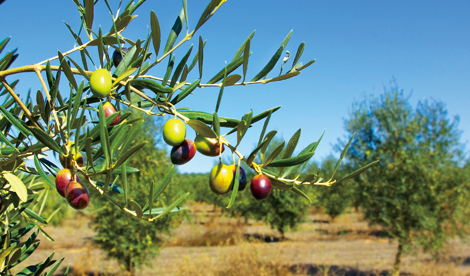In recent years some extraordinary claims have been made for olive oil. It has been credited with properties ranging from antioxidant to aphrodisiac.
Some assertions are more credible than others. A substantial body of scientific evidence now supports the theory that consumption of the oil can confer some health benefits such as lowering cholesterol to help prevent heart disease. Its restorative properties have been assumed for several thousand years around the Mediterranean, where the viscous golden liquid is a staple.

Due to an increased interest in healthier eating and as the taste has a broadly international appeal, the consumption of olive oil has gone global in recent years. Indeed, there are few developed countries in which a connoisseur would have any difficulty in locating a respectable bottle.
Made in Italy?
Perhaps the biggest myth of all about olive oil is that most of it comes from Italy when in fact the country doesn’t even produce enough for its own needs. Most of the olive oil labelled as “Bottled in Italy” or “Exported from Italy” was probably blended with oils from Spain, Greece, Morocco or Tunisia. Spain is the world’s largest exporter of olive oil and Italy the largest importer – much of it for re-export in subtly misleading packaging.
The good news is that although excellent olive oil is produced in Italy, equally good oils are made by other producers, often at much more reasonable prices, with different regional characteristics.
“Spanish oil has a nutty, fruity flavour while Italian oils tend towards the grassy and herbal side,” says Robert Petzold, executive chef of Hong Kong’s Boqueria Spanish restaurant. “Many Italian oils are actually blended with Spanish and Greek oils because they can be
quite astringent.”
Greek olive oil is known for its pungent flavour and aroma, notes Jon Irwin, chef de cuisine of Hong Kong’s French Michelin-starred restaurant Akrame restaurant. “As with wine, climate and soil conditions and different tree species account for differences in taste,” he says.
Skip the balsamic
The restaurant practice of placing olive oil on the table for diners to dip bread in – with or without an additional swirl of balsamic oil – is now internationally well established, but it does not have its origin in any of the countries in which olive oil has historically been produced.
“Good quality oil should never be mixed with vinegar if you want to appreciate the olive oil flavour and taste,” says Manuel Palacio Ramos, general manager of Hong Kong’s Pirata Italian restaurant. “The mix is kept for your salad as a dressing but never to dip the bread in.”

Restaurants in the US – by far the biggest export market for olive oil purporting to be from Italy and now also a significant producer in its own right – appear to have popularised this practice.
In Italy eating bread, with or without olive oil, before the antipasti and pasta courses is considered odd. Why would you be taking the edge off your appetite for the courses to come? If the restaurant is sufficiently informal the bread may be used for the Italian practice of “fare la scarpetta” – mopping up oil or sauce – later in the meal.
Most Mediterranean cultures agree that bread and olive oil go together, but it is usually drizzled on to a slice rather than being used for dipping – although that is something professional olive oil tasters do when judging oils.
Enriching dishes
Alessandro Cozzolino, chef de cuisine at the Grand Hyatt Hong Kong’s Grissini Italian restaurant, says olive oil plays an important role in his kitchen.
“For fish, I choose an oil that is delicate and light, just to accentuate the flavour of the sea. For meat, I select an intense olive oil, and for vegetables I use a fruitier extra virgin olive oil. Olive oil should be used ‘raw’ as far as possible, as heat makes it bitter,” he says.
Petzold says that in Spanish cuisine olive oil is used extensively for marinades, and that he likes to finish dishes with extra virgin olive oil because it adds body.
“We finish our octopus, piquillo peppers, ceviche, anchovy and many salads with olive oil to add extra body and richness. We also use premium oil in our sauces including Romesco, Mojo Verde and Chimichurri.”
Asian invasion
Olive oil use is beginning to make inroads into Asian kitchens. But in the former Portuguese enclave of Macau it has been incorporated into dishes for centuries, according to UK-based food writer Annabel Jackson, who recently co-authored The Yunnan Cookbook – Recipes From China’s Land Of Ethnic Diversity with Linda Chia.
“North of the Macau border in Zhuhai, it is not unusual to find fried rice studded with bits of black olive,” she adds.
“My book, Modern Indian Cooking, was entirely predicated on olive oil. The subtitle was ‘Where Did All The Ghee Go? The recipes were based on those developed by my co-author, Deepak Chauhan, who wanted to find healthy alternatives to ghee. Those who use these recipes attest to the lighter feel of the dishes.”
Chinese chefs cite the low smoke-point issue as a reason for not using olive oil for stir frying, but chef Jowett Yu of Hong Kong's modern Chinese restaurant Ho Lee Fook believes it can still have a role in some Asian dishes.

“I use olive oil in salads and cold plates as a dressing. Why use an oil with high cholesterol and no flavour when olive oil is healthier and adds more to the dish? I also use olive oil when I’m grilling to give extra flavour,” he says.
Pirata’s Ramos points out that Japanese teppanyaki restaurants are now substituting butter with olive oil. Takeda Yukio, chef de cuisine of the Grand Hyatt Hong Kong’s Kaetsu Japanese restaurant, uses olive oil in dressings, although not for cooking.
“Olive oil is one of the healthiest fats in the world – like fruit juice, it’s full of natural preservatives and good fatty acids that produce healthy cholesterol,” says Ramos. “Our body needs some fat to function, and since olive oil it is a vegetable oil full of non-fatty acids, it is easier for our body to get rid of after using the calories provided.
While other vegetable oils like grape seed, sunflower or peanut oil produce no distinctive flavour or aroma, olive oil brings a special touch to the cooking and helps in enhancing the original flavour of the ingredients,” he adds.








